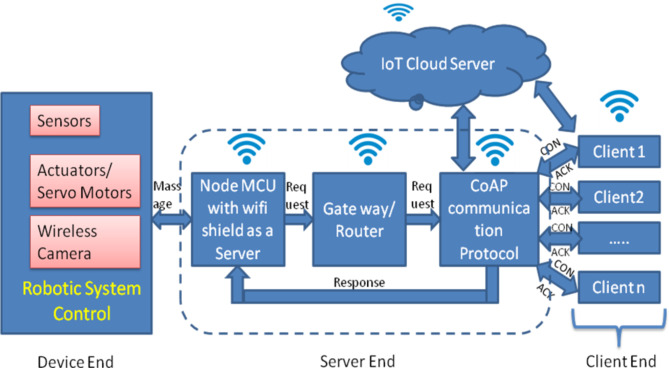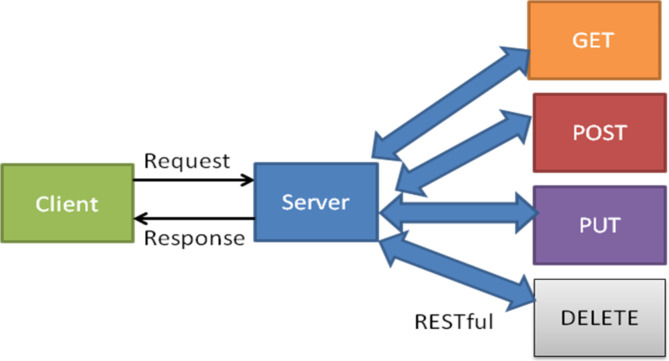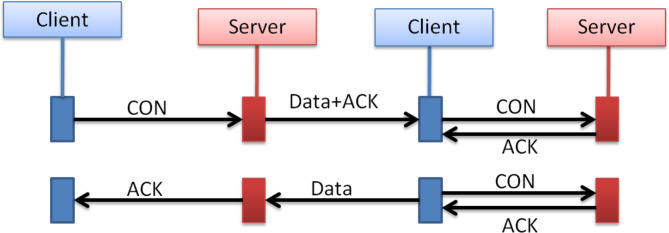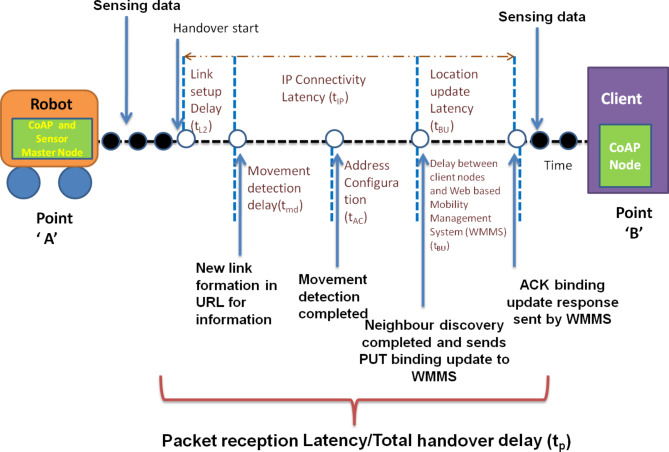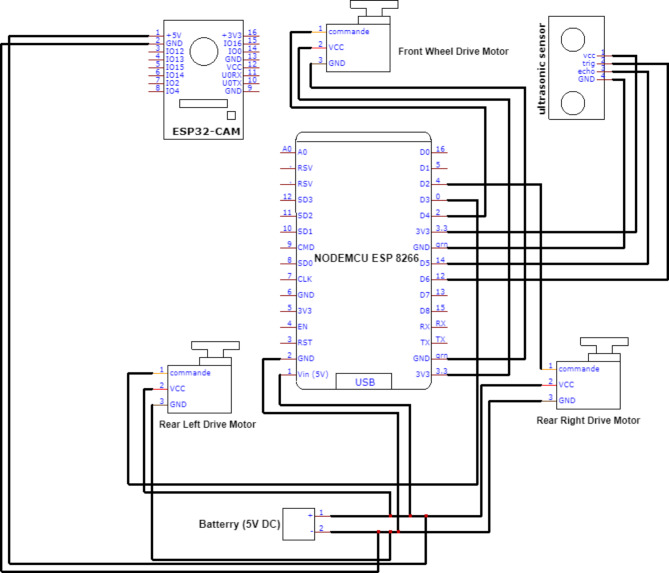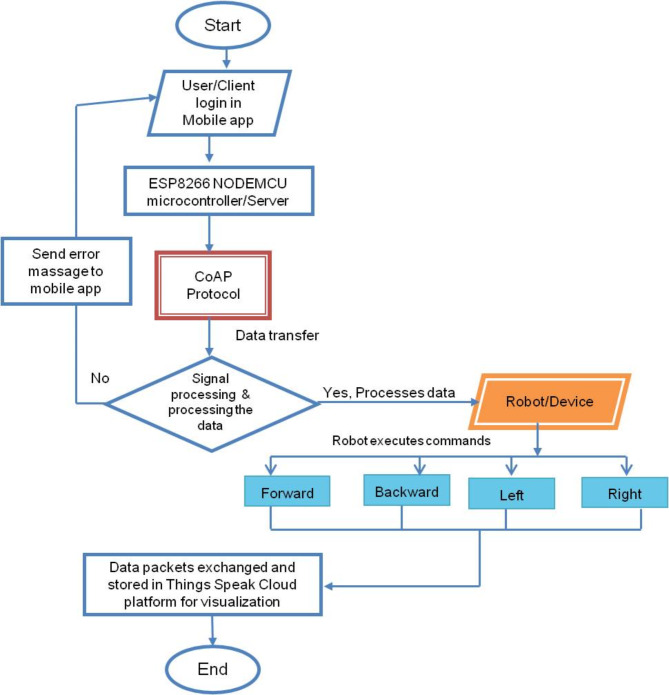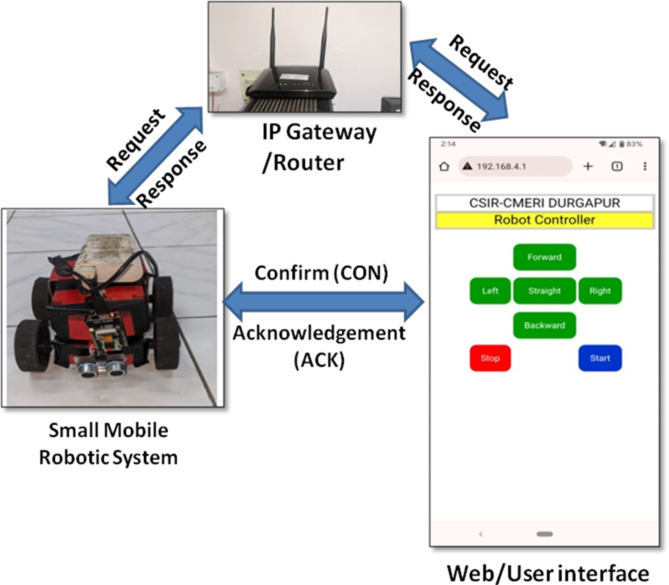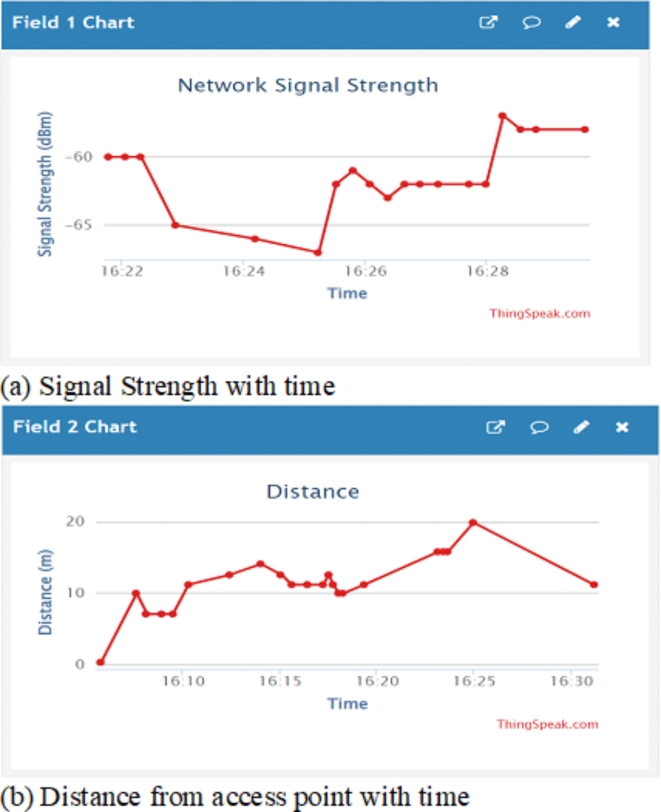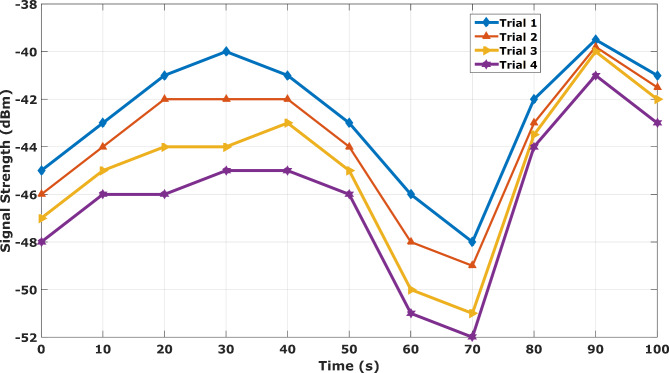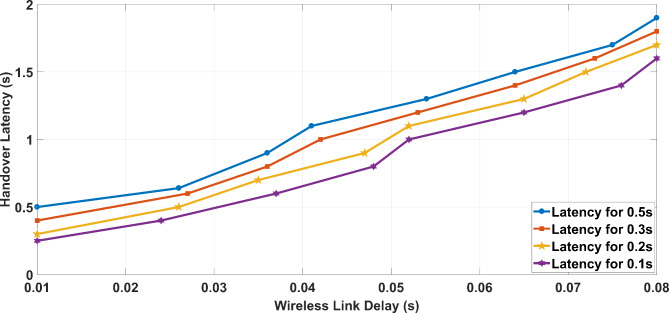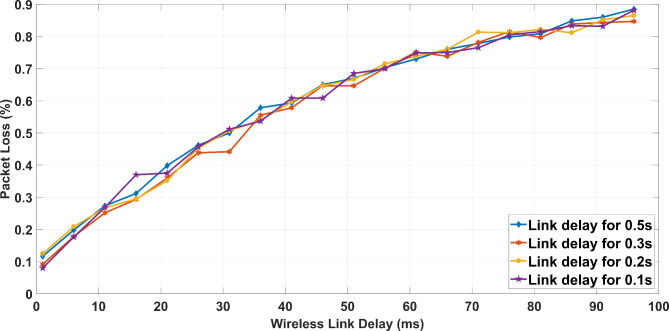Abstract
This paper proposes a novel design methodology of Constrained Application Protocol (CoAP) protocol for an IoT-enabled mobile robot system to operate remotely and access wirelessly. These devices can be used in different applications such as monitoring, inspection, robotics, healthcare, etc. For communicating with such devices, the different frameworks of IoT can be deployed to attain secured transmission using different protocols such as HTTP, MQTT, CoAP, etc. In this paper, the novel IoT-enabled communication using the CoAP protocol in mobile robotic systems is attempted. A mathematical analysis of the CoAP model is carried out where this protocol provides a faster response within less time and less power consumption as compared to other protocols. The main advantage of the CoAP protocol is to facilitate Machine-to-Machine (M2M) communication which contains features like small packet overhead and less power consumption. An experimental prototype has been developed and several trials have been conducted to evaluate the CoAP protocol’s performance for rapid communication within the mobile robotic system. Signal strength analysis is also carried out. This reveals that the reliability of sending signals is up to 99%. Thus, the application of the CoAP protocol shows enough potential to develop IoT-enabled mobile robotic systems and allied applications.
Supplementary Information
The online version contains supplementary material available at 10.1038/s41598-024-76713-2.
Keywords: IoT, CoAP, Mobile robotic system, Communication protocols, Cloud Computing etc
Subject terms: Engineering, Electrical and electronic engineering, Mechanical engineering
Introduction
In the present scenario, the global count of IoT-connected devices has increased from 15.1 billion in 2020 and it is estimated that by 2030 it will exceed 29 million1,2. These IoT applications serve various purposes, such as smart health monitoring systems, robotics, automated fire control, logistics, energy management, military surveillance, weapon systems, and many more3,4. IoT-based systems, combined with wireless networking, sensors, and communication channels, are adaptable solutions that can be applied for the specified applications. However, the security issues of the IoT domain remain highly unexplored, with the majority of IoT protocols operating at the network layer. IoT-based applications have exposed significant security vulnerabilities across various fronts, including IoT devices such as sensors and actuators, data storage devices, and notably, communication and controls between different devices. These vulnerabilities stem from the use of multiple communication protocols like HTTP (Hypertext Transfer Protocol), Message Queuing Telemetry Transport (MQTT), Constrained Application Protocol (CoAP), etc5,6. Given the resource-constrained nature of IoT environments, many of these protocols lack comprehensive information security features. For instance, MQTT, a widely utilized IoT communication protocol, lacks specific security standards, relying solely on authentication mechanisms without encrypting data in transit. This deficiency raises concerns regarding authentication, data integrity, and data privacy in MQTT implementations, particularly when transmitting sensitive information. However, the CoAP can be designed to be used with constrained devices, operating on a request-response model and supporting UDP protocols7. Specifically designed for devices with less power, faster computational speed, and less memory, CoAP serves as an alternative to MQTT where it’s unnecessary. With a compact 4-byte header, CoAP facilitates one-to-one communication and boasts smaller packet sizes compared to HTTP and Transmission Control Protocol (TCP). It finds applications in Machine-to-Machine (M2M) scenarios like building automation, robotics, smart energy, etc. CoAP has been developed by the Internet Engineering Task Force (IETF) Constrained RESTful Environments (CoRE) working group, which aims to develop a lightweight RESTful (HTTP) interface by Shelby et al.8. REST (Representational State Transfer), serves as the standard interface between HTTP clients and servers. In IoT contexts, CoAP’s architecture addresses this by enabling low-powered sensors to utilize a RESTful mechanism, minimizing power usage while meeting constrained requirements. Additionally, by employing the User Datagram Protocol (UDP) in place of the TCP, CoAP embeds reliability within its architecture. This strategic design ensures efficient communication while maintaining reliability in constrained environments. Previously, some researchers Chun et al.9,10, Gohar et al.11 and Pie12 have also attempted CoAP-based mobility management for IoT applications where they have presented the simulation analysis of the packet size of the data and its loss during sending the data using CoAP protocol within a network. However, our proposed work is focused on an IoT-enabled mobile robotic application using the CoAP protocol in this paper. The CoAP protocol communication features such as (Conformation (CON) and Acknowledgment (ACK)) are practically demonstrated in robotic applications on IoT-enabled mobile robotic systems with CoAP protocol remote monitoring in a moving environment which is the novelty of the proposed work. Therefore, a novel system architecture for CoAP protocol-based communication in mobile robotic systems using IoT technique is designed using four layers such as device/physical layer, communication/network layer, cloud computing/transport layer, and user/application layer. These layers are helpful in the development of CoAP protocol-based communication in mobile robotic systems. During the mobile robotic system operation, the device layer encloses a mobile robot, different sensors and actuators like ultrasonic sensors, motors, cameras, etc., and NodeMCU (ESP-8266 module) microcontroller for communicating with each other in the communication layer. The wireless communication between the cloud computing layer and the IoT devices are facilitated by the CoAP protocol, with an IoT cloud serving as a server for uploading data to the cloud. The user layer consists of various client devices, including mobile phones and PCs, which enable interaction between users and their devices.
The objectives of this paper are focused on the following points;
A novel design methodology for IoT-enabled communication using the CoAP protocol in mobile robotic systems.
CoAP is applied to achieve faster M2M communication for controlling the robot remotely.
Mathematical time analysis of the CoAP model for IoT communication in mobile robotic systems.
Development of experimental prototype and performance evaluation in real-time data analysis.
Store data in the cloud server and establish communication between different clients and server.
The paper is structured as follows: At first, a brief state-of-art of several IoT protocols utilized in mobile robotic systems for various applications is presented. Further, a novel design methodology for implementing the CoAP protocol communication in mobile robotic systems using the IoT technique is introduced. Further, a system architecture and mathematical analysis of the CoAP protocol for enabling IoT communication in mobile robot systems are discussed in a detailed manner. Further, the practical steps for creating an Android/web application are described that utilizes the CoAP protocol and an IoT platform. The development of an experimental prototype of the mobile robotic system is also discussed and multiple trials are also conducted to evaluate its performance by implementing the CoAP protocol. Finally, the conclusion of the paper is drawn.
State-of-art on various IoT protocols for communication in mobile robotic system
Previously, certain researchers have endeavored to develop IoT-enabled mobile robot systems, utilizing various protocols for monitoring, control, and their respective applications. Al-Fuqaha et al.13 have presented a brief report on IoT-enabling technologies, protocols, and applications, addressing challenges in applying IoT in cloud, fog computing, and big data analytics. Wallgren et al.14 have studied routing attacks and countermeasures in RPL-based IoT by exploring and emphasizing security features, utilizing the IPv6 protocol. Amaran et al.15 have attempted CoAP and MQTT performance in designing IoT devices for robotic applications. Mijovic et al.16 have compared application layer protocols for IoT applications through experimental analysis whereas Mun et al.17 have analyzed efficient communication protocols for resource-constrained IoT applications, focusing on energy, performance, and efficiency. Ghate et al.18 have utilized CoAP protocols for monitoring patient health conditions, enhancing the system with an open-source Python-based CoAP library. Ghosh et al.19 have introduced the robotic communication protocol by combining the sensing and control scheme of robots, incorporating MQTT-SN protocol for data publishing and subscribing using IoT techniques. Sethi et al.20 have provided an extensive review discussing various emerging protocols tailored for IoT applications, shedding light on evolving areas within the field. Additionally, the report delves into taxonomies pertinent to IoT technologies. Florea et al.21 have presented standardized protocols for networking in different environments suitable for embedded devices with low processing power, storage memory, and data rate. Bacco et al.22 have investigated the use of M2M/IoT protocol stacks on a satellite random access channel to minimize communication time. Scilimati et al.23 have focused on an IoT-enabled robotic system for environmental monitoring, incorporating CoAP protocols to connect IoT devices within a network. Kockemann et al.24 have integrated constraint-based planning with Lightweight Machine-to-Machine (LwM2M) in IoT networks to improve scheduling with low power energy consumption. Coetzee et al.25 have analyzed CoAP as a transport in IoT environments, demonstrating its effectiveness in low-power personal area networks. Hasan et al.26 have conducted an analysis of congestion mechanisms in CoAP and COCOA, utilizing MATLAB tools for effective bandwidth utilization. Yamin et al.27 have employed CoAP and MQTT protocols in a multi-robot platform for disaster management, utilizing a mesh topology for data transfer via the IoT cloud. Eggly et al.28 have implemented CoAP protocols to facilitate real-time communication with different sensors, actuators, and users. This application has the potential to enhance the human life within vulnerable environments, thereby contributing to societal welfare. Ruta et al.29 have devised a framework called Semantic Web of Things (SWoT), aimed at facilitating the collaborative creation of sensors and actuators within comprehensive contexts. This framework is built upon a backward-compatible extension of CoAP and is supported by sophisticated semantic matchmaking utilizing non-standard inference services. Furthermore, it establishes connectivity between mobile devices and smart phones. Aghenta et al.30 have developed an open-source library for IoT-based SCADA systems for faster communication compared to other IoT protocols where the MQTT protocol is applied using ESP32. Alfandi et al.31 have applied the IoT development boards, using Raspberry Pi as an advanced controller board to enhance security, including solving secure shell (SSH) issues. Rahman et al.32 have evaluated Peer Robot Communications using CryptoROS, developing a system architecture on a robot operating system (ROS) for peer-to-peer conversations between different nodes with security and privacy. Bhavsar et al.33 have focused on a Hybrid Robot-as-a-Service (RaaS) platform using MQTT and CoAP where the robot management system is developed and robot operation is performed with a communication center for the service industry. Belej et al.34 have focused on the use of data transmission protocols in wireless sensor networks. Their study delves into the specific application of the MQTT protocol in both speech and sensor networks on the internet, examining its diverse features and applications across various iterations. Srinivasa et al.35 have provided an extensive review encompassing architectures and diverse protocols aimed at enabling IoT applications. Their work focuses on integrating various applications for device perception and network communication, ultimately facilitating intelligent data processing. Dai et al.36 have focused on developing multi-functional robotic systems utilizing IoT methodologies for wireless data transfer, employing the MQTT protocol. This protocol, known for its robustness and lightweight nature, facilitates the seamless interconnection of multi-robotic technologies. Mitra et al.37 have presented a comprehensive study of different IoT protocols for smart city applications, utilizing sensors for environmental data collection and actuators for generating desired outputs. Tariq et al.38 have demonstrated the versatility of CoAP, showcasing its applicability across diverse domains such as home automation and the healthcare sector. They have illustrated how the CoAP protocol facilitates efficient communication within a short timeframe.
Patti et al.39 have explored a Media Access Control (MAC) protocol tailored for mobile cooperating robots, enabling communication via a wireless sensor network. This approach facilitates mobility and communications in real-time, and offers high scalability. Keung et al.40 have explored cloud-based CPS for improved warehouse management under various scenarios. Hamid et al.41 have provided a comprehensive report on IoT application layer protocols suitable for transmitting data within limited resource devices. Alejandrino et al.42 have focused on designing an optimal network and routing mechanism for precision farming, optimizing routes for a diversified mesh network for inter-organizational communication. Gundogan et al.43 have emphasized the importance of networking protocols for industrial communication services, recommending MQTT-SN with CoAP alongside information-centric networking (ICN) methods. Salam44 has modeled a communication protocol for IoT applications which is based on cryptographic primitives to allow security. Villa et al.45 have introduced an IoT methodology for a remote healthcare monitoring system, employing the CoAP protocol to enable swift remote data access and representation whereas Verma et al.46 have presented the multi-robot coordination analysis and taxonomy where the efficiency of multi-robot coordination is described in terms of communication mechanism, control architecture, decision-making, planning strategy, and scalability where challenges and future scope of work are also discussed. Makarem et al.47 have improved CoAP congestion control algorithms to enhance congestion detection in the network. Reddy et al.48 have implemented MQTT-SN edge gateway incorporation with a cloud server to store large amounts of sensor data for specific IoT applications. Takeshita et al.49 have developed a concept for real-time image transmission using CoAP without retransmission, utilizing stochastic transmission of blocks method for reception probability. Gavrilov et al.50 have applied different IoT protocols for analyzing tasks of robotics for autonomous systems, focusing on high data transmission and network organization efficiency. Srinivasa et al.51 have presented an analysis and dataset by combining IoT/operational technology (OT) honeypots to identify attack sources. Koul et al.52 have applied data exchange techniques to enhance communication methods for Internet of Robotic Things (IoRT). Kozel et al.53 have proposed a process method for identifying protocols using Boolean functions to aid in network design. Racz et al.54 have directed their attention towards PlatypOUs, a mobile robotic platform designed as an educational tool for STEM (Science, Technology, Engineering, and Mathematics) education and extracurricular activities. The primary goal of this physical robot is to enhance awareness of STEM fields beyond traditional educational frameworks. Additionally, they have developed a simulator aimed at providing students and self-learners with practical exercises, equipping them with the skills to tackle complex engineering challenges in a professional yet engaging manner. Tiberkak et al.55 have advanced the field of tele-robotics by employing IoT techniques to develop a web-based platform. This platform enables the monitoring and control of robots remotely by multiple users while minimizing task execution delays through the utilization of Web Real-Time Communication (WebRTC) technology, thereby enhancing connection and interaction efficiency. Chang et al.56 have conducted a study where they developed IoRT system for long-term services in a smart building system. This system utilized low-power consumption devices like Raspberry Pi and incorporated a variety of IoT protocols. Jain57,58 has carried out work on the experimental studies of a mobile robotic system using the IoT technique where HTTP protocol is applied and during sending the data, it takes time to communicate the robot and mobile app/web-based applications. Teji et al.59 have presented different methods for off-road mobile robots and wheel slippage estimation models with the sensing and control technologies whereas Kabir et al.60 have offered an in-depth examination of IoRT for mobile robots, delineating technological concepts and their practical applications. Furthermore, they address the challenges encountered in this domain and provide insights into futuristic directions.
According to the brief state-of-art report, some researchers have explored the application of IoT techniques in developing mobile robot systems for monitoring and inspection while the CoAP communication protocol has been used in limited robotics and other applications. Therefore, this paper proposes an IoT communication using CoAP in mobile robot systems for remote and wireless access operations. A novel feature of this paper involves the design methodology for IoT-enabled communication using the CoAP protocol in mobile robotic systems for monitoring and inspection. Various trials have been conducted to analyze the performance of the CoAP protocol in facilitating rapid communication within the mobile robotic system.
Design methodology for CoAP protocol communication in mobile robotic system using IoT technique
A novel design of system architecture for CoAP protocol-based communication in mobile robotic systems using the IoT technique is shown in Fig. 1. The four layers such as device/physical layer, communication/network layer, cloud computing/transport layer, user/application layer are designed for development of CoAP protocol based communication in mobile robotic system using IoT technique. During the operation of a mobile robotic system, at first, the device/physical layer contains a mobile robot where different sensors and actuators are integrated with the robotic system through NodeMCU (ESP-8266 module) microcontroller. For running the robot, the NodeMCU is linked to a Wi-Fi router in the communication/network layer which serves as a gateway to give information to clients in the User/Application layer. NodeMCU (ESP8266 module) provides the connectivity which is a relatively cheap and dedicated Wi-Fi module. Further, the ESP8266 module is connected via Wi-Fi to the server in the cloud communication layer/transport layer where data are sent through UDP protocols. ThingSpeak IoT cloud is used for storing the data and computation of data remotely.
Fig. 1.
Design concept of CoAP protocol-based communication in a mobile robotic system using IoT technique.
In the Thingspeak IoT cloud, the API key and channel ID are assigned which connects to the server. A robot containing a wireless camera and sensors is used to gather data in real time and provide information to the clients. During communication, a CoAP protocol is applied. The major advantage of the CoAP protocol is that it provides faster communication by assigning the request and response in the IoT cloud server. It also consumes less energy. For achieving the highest efficiency, UDP is used which sends data in small packets, and transition control is used by the web socket over the HTTP.UDP has fewer headers and lacks transport layers like confirm (CON) and acknowledgment (ACK) in an efficient manner so that the client and server communicate seamlessly. The CoAP system functions on a traditional client/server framework, where the CoAP server distributes various resources. Clients attempt the REST approach, employing GET requests for data retrieval and PUT or POST requests for data publication. A CoAP request is dispatched by a client to a server and obtained a response containing the desired data or action. On the other end, an Android smart phone/computer with an android/web application or client is connected to the server to obtain real-time data.
The advantages and disadvantages of different protocols are summarized to acquire the IoT-based communication data as given in Table 1.
Table 1.
Summary of advantages and disadvantages of different IoT communication protocols.
| S. No. | Parameters | HTTP | MQTT | CoAP | |||
|---|---|---|---|---|---|---|---|
| Advantage | Disadvantage | Advantage | Disadvantage | Advantage | Disadvantage | ||
| 1. | Auto configuration delay | Supported across different platforms and devices. HTTP has simple auto-configuration process. | HTTP is a heavier protocol with more overhead, which can lead to slower auto-configuration. | MQTT is lightweight and efficient protocols with limited bandwidth and high latency. It allows for quick auto-configuration. | MQTT requires a broker to manage communications, and the setup of this broker takes potential delays. | CoAP is used for constrained devices and networks. It has minimal auto-configuration delay and faster initial setup. | CoAP has limited support compared to HTTP and MQTT, communication delay in auto-configuration. |
| 2. | Detection delay during movement | Robust and reliable for static web applications. | High detection delay due to protocol overhead. | Quick detection and efficient in dynamic environments. | Dependent on broker availability and performance. | Very low detection delay for data communication | More delay on non-constrained networks. |
| 3. | Link setup delay | Simple and well-established setup process. | Slower due to heavier protocol. | Fast setup with low overhead. | Requires broker for setup, adding complexity. | Minimum setup delay compared to other protocols. | Limited support of protocol. |
| 4. | Location update delay | Updates in known environments. | High delay due to heavier protocol. | Efficient updates, low bandwidth use. | Broker dependency can introduce delays. | Low delay, efficient for constrained devices. | Limited support and application |
| 5. | IP connectivity delay | Universally supported | Higher delay due to extensive protocol. | Efficient in low bandwidth | Broker dependent and increase delay. | low connectivity delay | Limited support for connectivity. |
| 6. | Wireless-link bandwidth | Perform in high bandwidth environments. | High bandwidth consumption. | Use Low bandwidth. | Performance can degrade with high message rates. | Use minimum bandwidth. | Limited to low bandwidth applications. |
| 7 | Wireless-link delay | Performs in consistent environments. | High delay due to protocol size | Low delay, for real-time applications | Broker dependence can add delay. | Very low delay | Less effective in high-speed networks. |
| 8 | Control packet size | HTTP has large packet size. | Large packet size increases overhead. | Small packet size, efficient for constrained networks. | Limited by broker and bandwidth | Very small packet size for constrained devices. | Limited support and application flexibility. |
The list of items/components for the development of physical systems is given in Table 2.
Table 2.
List of resources for the development of physical systems.
| S. No. | Hardware/Materials/System | Functional requirement |
|---|---|---|
| I. | Mobile robotic system | A prototype of mobile robotic system is developed using a 4-wheel drive mechanism at CSIR-CMERI. |
| II | Ultrasonic sensors (Model: HC-SR04, Make: China) | The ultrasonic sensor is used for measuring the distance to an object by utilizing ultrasonic sound waves. It employs a transducer to transmit and receive ultrasonic pulses, which provide feedback regarding the object’s proximity. |
| III. | Gas sensors (Model: MQ-135, Make: India) | The gas sensor is used for identifying various gases such as Ammonia, Sulfur, Benzene, Carbon Dioxide, as well as other hazardous gases and smoke from the environment. |
| IV. | Wireless cameras (Model: ESP32-CAM board, Make: China) | A ESP32-CAM based wireless camera is used for smart IoT applications, including online wireless video monitoring, WiFi image uploads, and more. |
| V. | Supply DC Power (Customize at CSIR-CMERI) | A low voltage DC supply is also taken for providing the DC power to different sensors and actuators which can run the camera, microcontrollers, sensors, actuators, etc. |
| VI. | Router [Model: D-link, Make: Taiwan] | A router is employed to establish wireless connections for IoT gateways, enabling the transmission of data in small packets to be forwarded to the IoT cloud via the internet. |
| VII. | Relay (Dual Channel) | A dual-channel relay is employed to switch the appropriate state for activating or deactivating the sensor and actuators. |
| VIII. | Android Studio | The Android Studio software serves as an integrated development environment (IDE) that enables Java developers to utilize open-source code within their development tools. |
| IX. | IoT Thing speak® cloud platform | IoT ThingSpeak® cloud platform serves as a storage and data processing solution, equipped with a highly scalable real-time event processing engine. Users can leverage the platform by creating a login account, enabling them to register and access data for analytical purposes. Additionally, users can establish new channels to visualize sensor and actuator data, utilizing two distinct types of application programming interface (API) keys: READ and WRITE keys. These can be used to read and write data in the script. |
System architecture for CoAP protocol and communication in IoT enabled mobile robotic system
Design of system architecture of CoAP protocol for communication in IoT enabled mobile robotic system
The system architecture for controlling various sensors and actuators using ESP 8266 microcontroller and CoAP protocols is shown in Fig. 2. It consists of device end, server, and client end. The device end which moves as per the user’s demand by using a NodeMCU microcontroller (as a server that generally processes the command coming from the client end). Afterwards, the robotic system is connected to a router which serves as a gateway that works as per a client’s instruction. The connectivity is provided by the ESP8266 (NodeMCU) module, an extremely cheap and popular Wi-Fi module, also used as a server where CoAP protocol is designed to operate over constrained networks, which have limited bandwidth and resources. In a CoAP network, devices can function as servers, clients, or both and clients send requests to servers, which reply with relevant data or actions to start a conversation. Incoming requests are processed by servers, which take appropriate action and generate responses with the desired information. The robot is connected to a router which serves as a gateway to give information to clients.
Fig. 2.
System architecture for controlling different sensors and actuators using a microcontroller and connected to CoAP protocols using IoT technique.
CoAP resources are identified using Uniform Resource Identifiers (URIs) that represent data, and services when a device exposes to the network. Clients interacts with resources on servers using RESTful methods including GET, POST, PUT, DELETE methods as shown in Fig. 3. When a client sends a GET request, it asks the server to provide information about the resource’s current status. The POST method is used for creating new resources on the server and submitting data for processing. The PUT method is used when clients want to modify the content or properties of resources. If the resource doesn’t exist, PUT can be used to create new resources. When a client sends a DELETE request, it asks the server to eliminate the specified resource. The real time data i.e. number of packets sent from client to device end, data collected by sensors, etc. are represented and can be plotted using “Thingspeak” IoT cloud platform and data can be visualized and controlled from Android/ web-based application using CoAP protocol via IoT Platform.
Fig. 3.
CoAP protocol methods for IoT communication in mobile robotic system.
The command protocol of the CoAP model is shown in Fig. 4. The CoAP protocol model is designed for constrained devices which is based on a request-response model and supports UDP protocols. Mostly, this is used for automation with several constrained devices. The main advantages of the CoAP protocol are that it requires less computational power, less power consumption, and less memory size as compared to other protocols. CoAP protocols assist one-to-one communication with the feature of smaller packets. The CoAP is a gathering layer that is designed using IETF Constrained Restful Environment (Core). This also provides a lightweight RESTful as compared to the HTTP interface. The CoAP architecture is designed to enable the sensor where this device requires low power and set achievement or target of constraint environment. The user protocol is used as the transition control protocol which provides consistency in the CoAP architecture. The CoAP architecture consists of distinct layers:
Fig. 4.
Command protocol for CoAP model in an IoT-enabled mobile robotic system.
Communication/Information Layer.
Permission/Acknowledgment Layer.
In CoAP architecture, the UDP is used for messaging the information rather than TCPs which is more reliable. The sub-layer of messaging ensures message reliability and duplication, whereas the request/response sub-layer handles communication. The confirmable and non-confirmable modes perform data transmission tasks independently, which can be utilized for confirmation (CON)/acknowledgment (ACK) of the message.
For mathematical time analysis of the CoAP protocol for communication, the schematic diagram is shown in Fig. 5. The latency/time analysis plays a vital role in computer networking and communication systems which provides impact during the performance and responsiveness of various applications, especially those that require real-time interactions or rapid data transformation. The network latency can be improved by sequencing of packets data analysis, where we can make network routing with high-priority applications such as data transfer at the center traffic first then delaying process to another type of traffic arrangement for robotic system.
Fig. 5.
Mathematical representation for time analysis model for CoAP protocol.
The basic architecture comprises a CoAP client node, a CoAP server, and a web-based mobility management system (WMMS) in the robotic system10. Delay analysis may stem from signaling messages exchanged between CoAP nodes and WMMS, denoted as A and B representing one-way signaling and CoAP node and time can be calculated.
For this purpose, the mathematical modeling for delaying the signal message connected with a CoAP node is established and a WMMS wirelessly is also sent in one way where we need to consider several factors that contribute to this delay. These factors include:
 Signaling message transferring delay between nodes A and B in one way
Signaling message transferring delay between nodes A and B in one way
 Size of the signaling message
Size of the signaling message
 Bandwidth of the wireless link
Bandwidth of the wireless link
 Link delay of the wireless link.
Link delay of the wireless link.
The signaling message transferring delay during wireless link at one way is given by:
 |
1 |
The total handover delay can be formulated as the addition of the individual delays:
 |
2 |
Where,
 Auto-configuration delay
Auto-configuration delay
 Movement detection delay
Movement detection delay
 Link setup delay
Link setup delay
 Location update delay
Location update delay
 IP connectivity delay.
IP connectivity delay.
The auto-configuration delay refers to the timeframe for the duplicate address detection process, while the delay of movement detection signifies the period within which a CoAP node determines if it remains within the same network domain. Conversely, the handover delay shows the duration of the link layer handover procedure. Table 3 is utilized for evaluating the mathematical aspects of handover latency and packet loss during the handover process.
Table 3.
Simulation parameters for analyzing the handover latency and packet loss.
| Parameter | Symbol | Value |
|---|---|---|
| Auto-configuration delay |

|
200 ms |
| Detection delay during movement |

|
100 ms |
| Link setup delay |

|
50 ms |
| Location update delay |

|
500 ms |
| IP connectivity delay |

|
10 ms |
| Wireless-link bandwidth |

|
15 ms |
| Wireless-link delay |

|
10–200 kb/s |
| Control packet size |

|
50 bytes |
Using above data, the simulation is performed using MATLAB software as shown in Fig. 6. The graph reveals that as the wireless link delay increases, there is a corresponding increase in handover latency. Handover latency is the time it takes for a mobile device to switch from one base station to another. Wireless link delay is the time it takes for a data packet to travel between a mobile device and a base station. The results of this simulation show that wireless link delay is a significant factor in handover latency. This is because, when a mobile robotic system is moving between base stations, it needs to transmit data packets to both base stations in order to maintain its connection. The longer the wireless link delay, the longer it takes for these data packets to travel, and the longer it takes for the handover to complete the communication of sensor data of robotic system using CoAP protocol in IoT technique. The key advantages of CoAP in mobile robotic systems include its ability to support mobility in management protocols and enable IP protocols in sensor nodes without the need to modify the transport layer. Furthermore, CoAP achieves these benefits with minimal signaling overhead, zero packet loss, and consideration for the snooze/wakeup mode of operation.
Fig. 6.
Simulation result for analyzing the wireless link delay on handover latency using CoAP protocol.
Methods
Development of circuit diagram for an Android/ web-based application using CoAP protocol and IoT platform
The small mobile robotic system integrates ultrasonic sensors, a wireless camera, and servo motors, all linked to a server known as NodeMCU ESP 8266. Featuring 17 GPIO pins, some dedicated to communication while others support PWM (Pulse Width Modulation), it facilitates interfacing with the external environment via motors, sensors, and actuators, boasting built-in Wi-Fi capability. Operating solely on 3.3 VDC, the ESP-8266 module necessitates an external power source exceeding 3.3 VDC to prevent damage. Thus, a 5.0 V DC battery powers the system. Three servo motors execute movements according to client commands, powered via the connection of the red and brown wires to the battery’s first and second pins, with an orange wire transmitting PWM signals. The left and right rear drive motors connect to the 5.0 VDC battery for robot movement, while the forward-wheel drive motor enables directional changes, with the NodeMCU supplying voltage through the V3 pin. PWM pins of the rear drive motors and front-wheel drive motor link to the NodeMCU’s D4, D3, and D2 I/O pins respectively as shown in Fig. 7.
Fig. 7.
Circuit diagram for IoT-enable mobile robotic system using CoAP protocol.
Furthermore, the NodeMCU interfaces with a wireless ESP-32 CAM camera and an ultrasonic sensor. The ESP32-CAM, housing Bluetooth and Wi-Fi, enhances video capture and wireless communication. The camera detects and captures images, while the ultrasonic sensor anticipates obstacles in the robot’s path. Powering the camera requires a 5.0 VDC battery, while the HC-SR04 ultrasonic sensor, a 4-pin module, operates on 3.3 VDC. Its Trigger and Echo pins connect to NodeDMCU’s D5 or D6 I/O pins. Ground pins of the NodeMCU, ESP32 CAM Camera, ultrasonic sensor, drive motors, and 5.0 V DC battery complete the circuit. This setup effectively connects various electronic components to the NodeMCU’s GPIO pins, enabling seamless operation.
The flowchart for controlling IoT-enabled mobile robotic systems using the CoAP protocol is shown in Fig. 8. The user interacts with a mobile app that is developed using an Android/Web-based application for establishing a secure and persistent connection with an ESP8266 NODEMCU/server. The user/client, which can be a laptop or mobile device, communicates with the robot. The end-to-end communication is facilitated using the CoAP protocol, which utilizes UDP to communicate with IoT devices that have limited resources efficiently. CoAP achieves this by reducing overheads, accelerating data flow, simplifying deployment, and enabling asynchronous interactions.
Fig. 8.
Flow chart for development of Android / Web-based application using CoAP protocol.
During the interaction, the user sends control commands through the CoAP protocol. The user interacts with a mobile app that is developed using an Android / Web-based application for establishing a secure and persistent connection with an ESP8266 NodeMCU/server. The user/client, which can be a laptop or mobile device, communicates with the robot. The end-to-end (M2M) communication is facilitated using the CoAP protocol, which utilizes UDP to communicate with IoT devices that have limited resources efficiently. CoAP achieves this by reducing overheads, accelerating data flow, simplifying deployment, and enabling asynchronous interactions. During the interaction, the user sends control commands through the CoAP protocol. The CoAP server processes these commands, and the robot receives the incoming requests and executes the required actions, such as moving forward, backward, left, or right accordingly. All data packets transferred, including delays and latencies between them, are plotted on the Thingspeak platform. The process concludes after the robot has completed the necessary requests. If a signal is not processed successfully, an error message is sent back to the mobile app.
Results and discussions
A prototype of an IoT-enabled mobile robotic system using CoAP protocol has been developed as shown in Fig. 9. The main components for IoT communication in mobile robotic system using CoAP protocols are the identification of IP gateways and the sending of requests and responses to robots and gateways which are connected to a web user interface. All working together to facilitate seamless communication and interaction between users and the robot. The mobile robot possesses two communication methods either it can communicate with the web user interface via a router or directly communicate with the user. When communicating with the web user interface through the router, data exchange occurs over networks like Wi-Fi, etc. Acting as an intermediary, the router enables the transmission of data packets between the robot and the web user interface, allowing for bi-directional communication. This pathway enables the exchange of commands, instructions, and data, empowering remote control and monitoring of the robot’s activities. In contrast, direct communication with the user allows users to issue commands, receive feedback, and engage in real-time interaction with the robot independently of external infrastructure using IoT technique via confirm (CON) and acknowledgment (ACK) of CoAP communication protocols.
Fig. 9.
Development of IoT communication in a mobile robotic system using CoAP protocol.
During the sending of the data, the network signal strength and distance graph are also visualized in the ThingSpeak IoT cloud platform as shown in Fig. 10. The display of the relationship between network signal strength is obtained in dBm, indicating the power level of the received signal and the distance from the robot to a network access point or router measured in meters. These graphs show how the signal strength varies as the robot moves away from or closer to the access point, which is applied to optimize the performance and reliability of communication between the robot and Wi-Fi access point. These real time data show the tangible variation of network signal strength with the distance of robot and connectivity between robot and the router.
Fig. 10.
Screen Shot of signal strength in Think speak IoT Cloud platform for data analysis.
The experimental data for signal strength using the CoAP protocol is collected as given in Table 4. Several trials are also conducted. In each experiment, the network signal strength is measured at regular intervals, the data is also plotted as shown in Fig. 11. This indicates that the signal strength fluctuates over time, providing valuable insights into the variations in network conditions.
Table 4.
Experimental data for signal strength using CoAP protocol.
| S No | Time (s) | Signal Strength data Trial 1 | Signal Strength data Trial 2 | Signal Strength data Trial 3 | Signal Strength data Trial 4 |
|---|---|---|---|---|---|
| 1 | 0 | -45 | -46 | -47 | -48 |
| 2 | 10 | -43 | -44 | -45 | -46 |
| 3 | 20 | -41 | -42 | -44 | -46 |
| 4 | 30 | -40 | -42 | -44 | -45 |
| 5 | 40 | -41 | -42 | -43 | -45 |
| 6 | 50 | -43 | -44 | -45 | -46 |
| 7 | 60 | -46 | -48 | -50 | -51 |
| 8 | 70 | -48 | -49 | -51 | -52 |
| 9 | 80 | -42 | -43 | -43 | -44 |
| 10 | 90 | -40 | -39 | -40 | -41 |
| 11 | 100 | -41 | -41 | -42 | -43 |
Fig. 11.
Experimental plot of network signal strength with time using CoAP protocol.
Table 5 illustrates the data regarding handover latency and wireless link delays for four different trial times: 0.5, 0.3, 0.2, and 0.1 s. The handover latency is plotted on the X-axis, while the wireless link delay is plotted on the Y-axis as shown in Fig. 12. This demonstrates the variation in handover latency of the mobility protocol with wireless link delay.
Table 5.
Experimental and theoretical data of handover latency with wirelessly linked delay.
| S. No | Time (s) | Handover Latency(s) at X-axis | Linked Delay(s) at Y-axis | ||
|---|---|---|---|---|---|
| Simulation data | Experimental data | Simulation data | Experimental data | ||
| 1. | 0.5 | 0.010 | 0.010 | 0.5 | 0.5 |
| 0.026 | 0.026 | 0.6 | 0.64 | ||
| 0.036 | 0.036 | 1.9 | 0.9 | ||
| 0.041 | 0.041 | 1.1 | 1.1 | ||
| 0.054 | 0.054 | 1.3 | 1.3 | ||
| 0.064 | 0.064 | 1.5 | 1.5 | ||
| 0.075 | 0.075 | 1.7 | 1.7 | ||
| 0.08 | 0.080 | 1.9 | 1.9 | ||
| 2. | 0.3 | 0.01 | 0.010 | 0.4 | 0.4 |
| 0.026 | 0.027 | 0.5 | 0.6 | ||
| 0.036 | 0.036 | 0.8 | 0.8 | ||
| 0.041 | 0.042 | 1 | 1 | ||
| 0.054 | 0.053 | 1.2 | 1.2 | ||
| 0.064 | 0.064 | 1.4 | 1.4 | ||
| 0.075 | 0.073 | 1.6 | 1.6 | ||
| 0.08 | 0.08 | 1.8 | 1.8 | ||
| 3. | 0.2 | 0.010 | 0.010 | 0.32 | 0.3 |
| 0.026 | 0.026 | 0.4 | 0.5 | ||
| 0.036 | 0.035 | 0.7 | 0.7 | ||
| 0.041 | 0.047 | 0.9 | 0.9 | ||
| 0.054 | 0.052 | 1.1 | 1.1 | ||
| 0.064 | 0.065 | 1.3 | 1.3 | ||
| 0.075 | 0.072 | 1.5 | 1.5 | ||
| 0.080 | 0.080 | 1.7 | 1.7 | ||
| 4. | 0.1 | 0.01 | 0.01 | 0.25 | 0.25 |
| 0.026 | 0.024 | 0.3 | 0.4 | ||
| 0.036 | 0.037 | 0.6 | 0.6 | ||
| 0.041 | 0.048 | 0.8 | 0.8 | ||
| 0.054 | 0.052 | 1 | 1 | ||
| 0.064 | 0.065 | 1.2 | 1.2 | ||
| 0.075 | 0.076 | 1.4 | 1.4 | ||
| 0.080 | 0.080 | 1.6 | 1.4 | ||
Fig. 12.
Experimental performance handover latency with wireless linked delay.
Figure 13 illustrates the correlation between packet loss and different wireless link delays. The measurement of packet loss relative to the wireless link delay is conducted with a packet arrival rate set at 10 packets per second. The wireless link delay ranges from 0 s to 100 s, showcasing an increase in packet loss as the wireless link delay grows. This analysis is based on a packet size of 1024 bytes and a constant packet arrival rate of 10 packets per second. The packet data loss is to be found approximately 1.0%. It means that the system is reliable upto 99.0%.
Fig. 13.
Performance evaluation of the packet data loss with wireless link delay.
Table 6 depicts the results obtained from four trials conducted with time for three protocols i.e. HTTP, MQTT, and CoAP. The X-axis represents network signal strength, while the Y-axis represents distance. Network signal strength represents how strong or weak the signal is which can affect the speed and reliability of data transmission over a network.
Table 6.
Experimental data of different trials with processing time.
| S.No. | Name of IoT protocol | Processing time (s) | |||
|---|---|---|---|---|---|
| Trial 1 | Trial 2 | Trial 3 | Trial 4 | ||
| 1. | CoAP | 9 | 35 | 75 | 99 |
| 2. | MQTT | 12 | 49 | 98 | 145 |
| 3. | HTTP | 18 | 74 | 144 | 217 |
After conducting various trials, the experimental evaluation of the IoT-enabled mobile robotic system reveals that the system is remotely managed and governed through web/app-based applications, employing IoT techniques with three protocols: CoAP, MQTT, and HTTP.The system utilizes a cost-effective NodeMCU (ESP8266) microcontroller for wireless communication, working as a server for communication between the client end and the robot/device end. Comparative analysis of IoT protocols (MQTT, HTTP, and CoAP) is also prepared as given in Table 7. It shows that CoAP output performance in terms of communication speed, transmitting data rate is faster as compared to MQTT and HTTP.Consequently, exploring the CoAP protocol enables the system to achieve faster wireless control of mobile robots, particularly advantageous in mobile robotics applications.
Table 7.
Comparison study of various IoT protocols in terms of physical parameters.
| S. No | Particulars | Comparison of different IoT protocols | ||
|---|---|---|---|---|
| CoAP | MQTT | HTTP | ||
| 1. | Architecture | Client-Server URL based | Publish-Subscribes through MQTT Broker | Send-Receive massage based |
| 2. | Transport/Gateways | UDP | TCP | TCP/IP |
| 3. | Quality of Service (QoS) | Confirm (CON)-Acknowledgement (ACK) massage | Massage delivered at least once | Massage sent over the traffic control |
| 4. | Security | Datagram Transport Layer Security (DTLS) | Transport Layer Security (TLS) | TLS/ Secure Sockets Layer (SSL) |
| 5. | Communication/ Response time | Faster | Faster | Moderate |
| 6. | Header Size | 4 byte | 2 byte | 8 byte |
| 7. | Message overhead | Header data is in binary format. | Header data is in binary format. | Header data is in text format as compression is possible |
The novelty of this paper is that under.
-
i.
A novel design methodology for IoT-enabled communication using the CoAP protocol in mobile robotic systems is developed with the integration of physical devices. In constrained network environments, the CoAP protocol is applied which contains a small packet size enabling a high degree of communication with faster response.
-
ii.
M2M applications and controlling the robot remotely are achieved where CoAP is applied for achieving IoT technique which has less central processing unit (CPU), low memory, less power supply, and high-efficiency capabilities.
-
iii.
A prototype for remote and wireless controlling and monitoring of the mobile robotic systems is developed using CoAP protocol where some data in packets are sent from client to device and vice-versa in real-time data. The sensors and servo motors are connected to robots where sensor and motor data are sent to the IoT server through CoAP. This robotic system can be used IoT-enabled environment.
After these studies, it is envisaged that the CoAP protocol presents itself as a versatile solution with an application layer and a web-based protocol suitable for the development of constrained devices, such as sensors and actuators, across various domains including robotics, healthcare, medical assistive devices, logistics, and energy management etc. These applications require systems with limited memory and processing power but necessitate faster response times. Leveraging the CoAP protocol, which operates at the application layer, offers a streamlined approach to communication wirelessly. Utilizing UDP as the communication gateway proves to be significantly faster, simpler, and more efficient in comparison to TCP/IP. Therefore, an IoT-enabled mobile robotic system utilizing CoAP protocols has been developed. This system showcases its capabilities in monitoring the environment and facilitating data movement through a client-server IoT protocol. It efficiently collects and stores sensor node data over networking infrastructures to meet the demands of emerging robotics and related fields.
Conclusion
In this paper, a novel concept of CoAP protocol-based communication in mobile robotic systems using IoT technique is applied which sends a request-response with the devices and is supported by UDP protocols. The CoAP architecture is meticulously designed to empower sensors in low-power environments, where devices operate under constrained environment. The user protocol functions as a vital control mechanism, securing the reliability within the CoAP framework. Initially, when there’s a low packet loss rate, CoAP processes a smaller amount of data. However, as the size of the transmitted message grows, CoAP becomes capable of handling larger volumes of data. Signal strength analysis is also carried out which reveals the capability to handle significant volumes of data where the mobile user agent is capable of realizing devices and data. During operation, the packet data loss occurs around 1.0%, So, CoAP protocols show steady-state data up to 99%. Thus, data can be rapidly stored on the cloud server using CoAP protocols for evaluating the performance of mobile robotic systems in monitoring the environment. This kind of IoT-enabled mobile robotic system using CoAP demonstrates the potential of a new generation of robotic systems.
Electronic supplementary material
Below is the link to the electronic supplementary material.
Acknowledgements
The authors are grateful to the Director of CSIR-CMERI, Durgapur, India, for providing permission to publish this paper. Ms. Chandra Sarkar and Mr. Amitava Das are currently pursuing their PhDs under AcSIR, CSIR-CMERI Durgapur, and this work constitutes a part of their respective Ph.D. theses.
Author contributions
R.K.J., C.S., and A.D. wrote the manuscript text, C.S. and A.D. conducted the experiment(s), and C.S. and A.D. along with R.K.J. analyzed the results. All authors reviewed the manuscript.
Funding
No financial support was obtained for the creation of this manuscript.
Data availability
“Data is provided within the manuscript or supplementary information files.”
Declarations
Competing interests
The authors declare no competing interests.
Ethical approval
There is no direct involvement in Human Participants and/or Animals in this paper. This paper may be published in the traditional publishing model.
Consent to participate
The manuscript is not to be submitted to more than one journal for simultaneous consideration.
Consent to publish
We are giving content about publication through the peer-reviewed process in this journal.
Footnotes
Publisher’s note
Springer Nature remains neutral with regard to jurisdictional claims in published maps and institutional affiliations.
References
- 1.Ramson, S. R. J., Vishnu, S. & Shanmugam, M. Applications of Internet of Things (IoT) - An overview, 5th International Conference on Devices, Circuits and Systems (ICDCS), Coimbatore, India, pp. 92–95, doi: (2020). 10.1109/ICDCS48716.2020.243556
- 2.https://www.statista.com/statistics/1183457/iot-connected-devices-worldwide/
- 3.Elgazzar, K. et al. Revisiting the internet of things: new trends, opportunities and grand challenges. Front. Internet Things. 1, 1073780. 10.3389/friot.2022.1073780 (2022). [Google Scholar]
- 4.Hassija, V. et al. A Survey on IoT security: application areas, security threats, and solution architectures. IEEE Access. 7, 82721–82743. 10.1109/ACCESS.2019.2924045 (2019). [Google Scholar]
- 5.Frigieri, E. P., Mazzer, D. & Parreira, L. F. C. G. M2M protocols for constrained environments in the context of IoT: a comparison of approaches. Evento: XXXIII Simpósio Brasileiro De Telecomunicações (SBrT2015). 10.14209/sbrt.2015.4 (2015). [Google Scholar]
- 6.Thota, P. & Kim, Y. Implementation and comparison of M2M protocols for internet of things. 4th Intl Conf. Appl. Comput. Inform. Technology/3rd Intl Conf. Comput. Science/Intelligence Appl. Informatics/1st Intl Conf. Big Data Cloud Comput. Data Sci. Eng. 43–48. 10.1109/ACIT-CSII-BCD.2016.20 (2016).
- 7.Marti, M., Garcia-Rubio, C. & Campo, C. Performance evaluation of CoAP and MQTT_SN in an IoT environment. Proceeding. 31 (49). 10.3390/proceedings2019031049 (2019).
- 8.Shelby, Z., Hartk, K. & Bormann, C. Internet Engineering Task Force (IETF), June 2014 Available: https://www.rfc-editor.org/rfc/pdfrfc/rfc7252.txt.pdf
- 9.Chun, S. M., Park, J. T., Communications, I. E. E. E. & Conference, N. Mobile CoAP for IoT mobility management, 12th Annual and (CCNC), Las Vegas, NV, USA, pp. 283–289, doi: (2015). 10.1109/CCNC.2015.7157990
- 10.Chun, S. M., Kim, H. S. & Park, J. T. CoAP-Based mobility management for the internet of things. Sensors. 15, 16060–16082. 10.3390/s150716060 (2015). [DOI] [PMC free article] [PubMed] [Google Scholar]
- 11.Gohar, M., Choi, J. G. & Koh, S. J. CoAP-based group mobility management protocol for the internet-of-things in WBAN environment. Future Gener Comput. Syst. 18, 309–318. 10.1016/j.future.2018.06.003 (2018). [Google Scholar]
- 12.Pei, L. A mobility management algorithm in the internet of things (IoT) for Smart objects based on Software-defined networking (SDN). Int. J. Adv. Comput. Sci. Appl. 13 (11), 82–91 (2022). [Google Scholar]
- 13.Al-Fuqaha, A., Guizani, M., Mohammadi, M., Aledhari, M. & Ayyash, M. Internet of things: a survey on enabling technologies, protocols, and applications. IEEE Communication Surv. Tutorials. 17 (4), 2347–2376 (2015). [Google Scholar]
- 14.Wallgren, L., Raza, S. & Voigt, T. Routing attacks and countermeasures in the RPL-based Internet of Things, International Journal of Distributed Sensor Networks, (Article ID 794326) 11 pages, doi: (2013). 10.1155/2013/794326 (2013).
- 15.Amaran, M. H., Noh, N. A. M., Rohmad, M. S. & Hashim, H. A comparison of lightweight communication protocols in robotic applications, IEEE International Symposium on Robotics and Intelligent Sensors (IRIS Procedia Computer Science, 76, 400–405 (2015). (2015).
- 16.Mijovic, S., Shehu, E. & Buratti, C. Comparing application layer protocols for the Internet of Things via experimentation, IEEE 2nd International Forum on Research and Technologies for Society and Industry Leveraging a better tomorrow (RTSI), Bologna, Italy, pp. 1–5, doi: (2016). 10.1109/RTSI.2016.7740559
- 17.Mun, D. H., Dinh, M. L. & Kwon, Y. W. An assessment of Internet of Things protocols for resource-constrained applications, IEEE 40th Annual Computer Software and Applications Conference, Atlanta, GA, USA, 10–14 June, pp. 555–560, doi: (2016). 10.1109/COMPSAC.2016.51
- 18.Ghate, P. M. & Dharmkare, S. U. CoAP based healthcare monitoring system. Int. J. Industrial Electron. Electr. Eng. 5 (9), 13–17 (2017). [Google Scholar]
- 19.Ghosh, P., Tran, J. A., Dsouza, D., Ayanian, N. & Krishnamachari, B. ROMANO: A novel overlay lightweight communication protocol for unified control and sensing of a network of robots, Computer Science, Engineering, Published in arXiv.org, (2017).
- 20.Sethi, P. & Sarangi, S. R. Internet of things: architectures, protocols, and applications. J. Electr. Comput. Eng. 2017 10.1155/2017/9324035 (2017). (Article ID 9324035) 25 pages, doi.
- 21.Florea, A., Rughinis, R., Ruse, L. & Dragomir, D. Survey of standardized protocols for the Internet of Things, 21st International Conference on Control Systems and Computer Science, Bucharest, Romania, 29–31 May, pp. 190–196, (2017).
- 22.Bacco, M., Colucci, M. & Gotta, A. Application protocols enabling internet of remote things via random access satellite channels, IEEE International Conference on Communications (ICC), Paris, France, pp. 1–6, 10.1109/ICC.2017.7997292, (2017).
- 23.Scilimati, V. et al. Industrial Internet of things at work: a case study analysis in robotic-aided environmental monitoring. IET Wirel. Sens. Syst. 7 (5), 155–162. 10.1049/iet-wss.2017.0032 (2017). [Google Scholar]
- 24.Kockemann, U., Tsiftes, N. & Loutfi, A. Integrating constraint-based planning with LwM2M for IoT network scheduling, Workshop on AI for internet of things (AI4IoT), Stockholm, July 15 (2018).
- 25.Coetzee, L., Oosthuizen, D. & Mkhize, B. An Analysis of CoAP as transport in an Internet of Things environment, IST-Africa 2018 Conference Proceedings Paul Cunningham and Miriam Cunningham (Eds), IIMC International Information Management Corporation, 2018 (http:www.IST-Africa.org/Conference2018), (2018).
- 26.Hasan, H. M. & Ahmed, A. I. A comparative analysis for congestion mechanism in COAP and COCOA. Eng. Technol. J. 36 (Part A)(8), 867–885 (2018). [Google Scholar]
- 27.Yamin, M. I., Kuswadi, S. & Sukaridhoto, S. Real performance evaluation on MQTT and COAP protocol in ubiquitous network robot platform (UNR-PF) for disaster multi-robot communication. EMITTER Int. J. Eng. Technol. 6 (2), 369–385 (2018). [Google Scholar]
- 28.Eggly, G. M. et al. Real-time primitives for CoAP: extending the use of IoT for time constraint applications for social good. Proceedings. 2 (1257). 10.3390/proceedings2191257 (2018).
- 29.Ruta, M. et al. CoAP–based collaborative sensor networks in the semantic web of things. J. Ambient Intell. Humaniz. Comput. 10.1007/s12652-018-0732-4 (2018). [Google Scholar]
- 30.Aghenta, L. O. & Iqbal, M. T. Design and implementation of a low-cost, open source IoT-based SCADA system using ESP32 with OLED, things board and MQTT protocol. AIMS Electron. Electr. Eng. 4 (1), 57–86. 10.3934/ElectrEng.2020.1.57 (2019). [Google Scholar]
- 31.Alfandi, O. et al. Assessment and hardening of IoT development boards, Book chapter, M. Di Felice (Eds.): WWIC 2019, LNCS 11618, pp. 27–39. (2019). 10.1007/978-3-030-30523-9_3
- 32.Rahman, A. H. A., Sulaiman, R., Sani, N. S., Adam, A. & Amini, R. Evaluation of peer robot communications using CryptoROS. Int. J. Adv. Comput. Sci. Appl. (IJACSA). 10 (7), 658–663 (2019). [Google Scholar]
- 33.Bhavsar, P., Patel, S. H. & Sobh, T. M. Hybrid robot-as-a-service (RaaS) platform (Using MQTT and CoAP), International Conference on Internet of Things (iThings) and IEEE Green Computing and Communications (GreenCom) and IEEE Cyber, Physical and Social Computing (CPSCom) and IEEE Smart Data (SmartData), Atlanta, GA, USA, pp. 974–979, doi: 10.1109/iThings/GreenCom/CPSCom/SmartData.2019.00171(2019). [Available: https://ieeexplore.ieee.org/document/8875263].
- 34.Belej, O., Nestor, N., Sadeckii, J., Polotai, O. & Engineers Features of application of data transmission protocols in wireless networks of sensors, IEEE conference on Institute of Electrical and Electronics London, UK, 3–5 July, pp. 317–322, (2019).
- 35.Srinivasa, A. H. & Siddaraju A comprehensive study of architecture, protocols and enabling applications in internet-of-things (IoT). Int. J. Sci. Technol. Res. 8 (11), 1767–1779 (2019). [Google Scholar]
- 36.Dai, R., Kerber, E., Reuter, F., Stumm, S. & Cokcan, S. B. The digitization of the automated steel construction through the application of Microcontrollers and MQTT. Constr. Rob. 4, 251–259. 10.1007/s41693-020-00042-9 (2020). [Google Scholar]
- 37.Mitra, D., Goswami, S., Hati, D. & Roy, S. Comparative study of IoT protocols. Palarch’s J. Archaeol. Egypt/Egyptology. 17 (7), 1–14 (2020). [Google Scholar]
- 38.Tariq, M. A., Khan, M., Khan, M. T. R. & Kim, D. K. Enhancements and challenges in CoAP-A survey. Sensors. 20 (6391). 10.3390/s20216391 (2020). [DOI] [PMC free article] [PubMed]
- 39.Patti, G., Leonardi, L. & Bello, L. L. A novel MAC protocol for low data rate cooperative mobile robot teams. Electronics. 9 (235). 10.3390/electronics9020235 (2020).
- 40.Keung, K. L., Lee, C. K. M., Ji, P. & Ng, K. K. H. Cloud-based cyber-physical robotic mobile fulfillment systems: a case study of collision avoidance. IEEE Access. 8, 89318–89336 (2020). [Google Scholar]
- 41.Hamid, H. G. & Alisa, Z. T. Survey on IoT application layer protocols. Indonesian J. Electr. Eng. Comput. Sci. 21 (3), 1663–1672. 10.11591/ijeecs.v21.i3.pp1663-1672 (2021). [Google Scholar]
- 42.Alejandrino, J. D. et al. Protocol-independent data acquisition for precision farming. J. Adv. Comput. Intell. Intell. Inf. 25 (4), 397–403 (2021). [Google Scholar]
- 43.Gundogan, C. et al. The impact of networking protocols on massive M2M communication in the industrial IoT. IEEE Trans. Netw. Serv. Manage. 18 (4), 4814–4828. 10.1109/TNSM.2021.3089549 (2021). [Google Scholar]
- 44.Salam, M. N. Modeling of a communication protocol for IoT based applications. IOSR J. Comput. Eng. (IOSR-JCE). 23 (2), 01–07 (2021). [Google Scholar]
- 45.Villa, D., Song, X., Heim, M. & Li, L. Internet of Robotic Things: Current technologies, applications, challenges and future directions, Available: arXiv:2101.06256v1 15 Jan (2021).
- 46.Verma, J. K., Ranga, V. & Scope Multi-Robot Coordination Analysis, Taxonomy, Challenges and Future J. Intell. Robot Syst., 102 (10), doi: 10.1007/s10846-021-01378-2 (2021). [DOI] [PMC free article] [PubMed]
- 47.Makarem, N., Dia, W. B., Mougharbel, I. & Malouch, N. On the design of efficient congestion control for the constrained application protocol in IoT. Comput. Netw. 207 (1), 108824. 10.1016/j.comnet.2022.108824 (2022). [Google Scholar]
- 48.Reddy, M. O. & Seventline, J. B. Practical MQTT-SN edge gateway integration with cloud server and end to end sensor data transmission for IoT applications. J. Theoretical Appl. Inform. Technol. 100 (22), 6505–6514 (2022). [Google Scholar]
- 49.Takeshita, E. et al. Stochastic image transmission with CoAP for extreme environments. IEEE 95th VehicularTechnology Conference (VTC2022-Spring). 10.1109/VTC2022-Spring54318.2022.9860969 [Available: https://arxiv.org/abs/2205.01852] (2022).
- 50.Gavrilov, A., Bergaliyev, M., Tinyakov, S., Krinkin, K. & Popov, P. Using IoT protocols in real-time systems: Protocol analysis and evaluation of data transmission characteristics, Journal of Computer Networks and Communications, (Article ID 7368691) 18 pages, doi: (2022). 10.1155/2022/7368691 (2022).
- 51.Srinivasa, S., Pedersen, J. M. & Vasilomanolakis, E. Interaction matters: a comprehensive analysis and a dataset of hybrid IoT/OT honeypots, Annual Computer Security Applications Conference (ACSAC ’22), Austin, TX, 05–09 December, doi: (2022). 10.1145/3564625.3564645
- 52.Koul, N., Kumar, N., Sayeed, A., Verma, C. & Raboaca, M. S. Data exchange techniques for internet of robotic things: recent developments. IEEE Access. 10, 102087–102106. 10.1109/ACCESS.2022.3209376 (2022). [Google Scholar]
- 53.Kozel, V., Ivanchuk, O., Drozdova, I. & Prykhodko, O. Automation of the protocol selection process for IoT systems. Int. J. Comput. 21 (2), 251–257 (2022). [Google Scholar]
- 54.Racz, M. et al. PlatypOUs—A mobile robot platform and demonstration tool supporting STEM education. Sensors. 22, 2284. 10.3390/s22062284 (2022). [DOI] [PMC free article] [PubMed] [Google Scholar]
- 55.Tiberkak, A., Hentout, A. & Belkhir, A. WebRTC–based MOSR remote control of mobile manipulators. Int. J. Intell. Rob. Application. 7, 304–320. 10.1007/s41315-023-00281-3 (2023). [DOI] [PMC free article] [PubMed] [Google Scholar]
- 56.Chang, S. H., Hsia, C. H. & Hong, W. Z. A secured internet of robotic things (IoRT) for long–term care services in a smart building. J. Supercomputing. 79, 5276–5290. 10.1007/s11227-022-04845-1 (2023). [DOI] [PMC free article] [PubMed] [Google Scholar]
- 57.Jain, R. K. Experimental performance of mobile robotic system by involving IoT technique. J. Sci. Industrial Res. (JSIR). 81 (6), 573–583 (2022). [Google Scholar]
- 58.Jain, R. K. Development of IoT-enabled mobile robotic system for monitoring, In Advances in Robotics (AIR) 6th International Conference of The Robotics Society, IIT Ropar, India, Jul 5–8, pp. 1–6, doi: (2023). 10.1145/3610419.3610441(2023).
- 59.Teji, M. D., Zou, T., Zeleke, D. S. & Technology A Survey of Off-Road Mobile Robots: Slippage Estimation, Robot Control, and Sensing J. Intell. Robot Syst., 109 (38), doi: 10.1007/s10846-023-01968-2 (2023).
- 60.Kabir, H., Tham, M. L. & Chang, Y. C. Internet of robotic things for mobile robots: concepts, technologies, challenges, applications, and future directions. Digit. Commun. Networks. 9, 1265–1290. 10.1016/j.dcan.2023.05.006 (2023). [Google Scholar]
Associated Data
This section collects any data citations, data availability statements, or supplementary materials included in this article.
Supplementary Materials
Data Availability Statement
“Data is provided within the manuscript or supplementary information files.”




